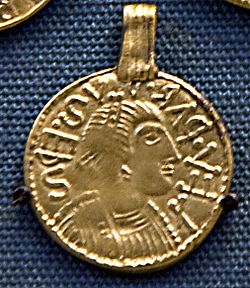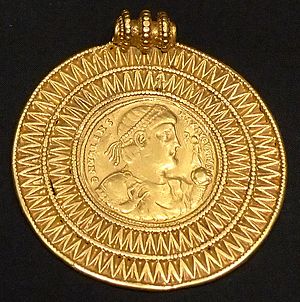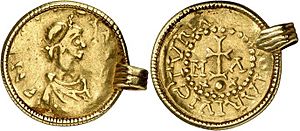Liudhard medalet facts for kids
Quick facts for kids Liudhard medalet |
|
|---|---|

Replica of the Liudhard medalet from the British Museum
|
|
| Material | Gold |
| Size | 1.57 grams (0.055 oz) |
| Writing | Latin inscription |
| Created | late 6th century AD |
| Discovered | 1840s |
| Present location | currently in the World Museum Liverpool |
| Identification | M7018 at the World Museum Liverpool |
The Liudhard medalet is a small, golden Anglo-Saxon coin or medal. It was found around 1844 near St Martin's Church in Canterbury, England. This special item was part of a collection of six objects called the Canterbury-St Martin's hoard. Today, the medalet and the other items from the hoard are kept at the World Museum Liverpool.
Most historians believe these items were buried together. They think they formed a necklace in a woman's grave from the 6th century. The medalet is set in a way that it could be worn as jewellery. On its front side, called the obverse, there's a robed figure with an inscription. This writing mentions Liudhard, a bishop who came to England with Bertha. Bertha married Æthelberht, who was the king of Kent. The back of the coin has a special double-barred cross, known as a patriarchal cross, along with more letters.
This medalet was probably made in Canterbury in the late 500s. It might have been used as a coin, but it was more likely a medallion. It was probably made to show that the person wearing it had become a Christian. The Liudhard medalet is the oldest surviving example of Anglo-Saxon coinage.
Contents
Finding the Medallion: How It Was Discovered
The Liudhard medalet was first shown to the public on April 25, 1844. A man named Charles Roach Smith presented it to the Numismatic Society. He also showed other coins that were found with it.
A collector named W. H. Rolfe bought the medalet and two similar items. Later, he bought five more items from the same collection. All eight items were written about in a magazine called Numismatic Chronicle in 1845. Smith only knew that the items had been found "a few years since" and that they were all found together.
Rolfe said that all the items were found in the churchyard of St Martin's in Canterbury. However, the first published report said they were found next door at St Augustine's Abbey.
Who Owned the Medallion?
The entire collection, including the medalet, was passed from Rolfe's collection to Joseph Mayer. Eventually, it became part of the Rolfe-Mayer collection at the City of Liverpool Public Museums. This collection is now known as the World Museum Liverpool.
Some experts, like S. C. Hawkes, think the eight items were found in different graves. They based this idea on special x-ray tests. But historian Philip Grierson disagreed. He thought it was very unlikely that two different graves would have coins from the exact same time period.
The medalet is part of the only discovery of gold jewellery from the late 500s or early 600s found in a churchyard grave. All the coins in the collection were probably part of a necklace. This necklace was likely buried in a woman's grave. The medalet itself is the earliest Anglo-Saxon coin that we still have today.
What Does the Medallion Look Like?
The Liudhard medalet is made of gold and has a small loop. This loop allowed it to be worn as jewellery.
The Front Side (Obverse)
On the front side, there is a picture of a man's upper body. He is wearing a special headpiece called a diadem and a robe. There are dots around the edge of this side. The words "LEV·DΛR·~VS·EPS" are written on this side. The writing goes from right to left, and the letters are also written backwards.
The letters "LEUDARDUS" are Latin for the name "Liudhard." The letters "EPS" are a short way of writing "EPiscopuS," which means "bishop" in Latin.
The Back Side (Reverse)
On the back of the coin, there is a patriarchal cross. This cross has two horizontal bars and sits on a base. Two small hanging pieces come down from the upper bar of the cross. A circle and two half-circles cross through the design of the cross.
Above the cross, upside down, are the letters "AA." The cross is surrounded by two sets of letters, each reading "NINΛ." Below the cross are the letters "VΛV." The entire medalet weighs about 1.57 grams (0.055 oz).
Who Is Liudhard?
Charles Roach Smith first thought the writing on the front named a bishop from the 6th century. However, other experts like D. B. Haigh and Arthur Evans believed it referred to Liudhard. Liudhard was a Frankish bishop who came with Princess Bertha from Francia to Kent. This happened in the late 6th century when the Christian Bertha married the pagan King Æthelberht of Kent. Liudhard likely died in the late 590s.
Where Did the Medallion Come From?

The coin that the medalet is based on was probably made in England, most likely in Canterbury. Arthur Evans thought it was made by a Frankish person in Liudhard's group. However, Philip Grierson was not as sure about that. Both agreed that it wasn't really meant to be used as money. Instead, it was likely made as a medallion to show someone had become Christian.
Historian Margaret Deanesly believed it was made in Canterbury by a local Jutish artist. Since King Æthelberht ruled during certain years, it seems the coin was made between 578 and 589. The loop for hanging it is similar to features on bracteates. These were pagan Germanic items, like coins, that were used as amulets or jewellery. They often showed a king, but they were only stamped on one side.
Similarities to Other Coins
The front side of the medalet looks similar to coins from Merovingian France, especially from the southern parts. It also shows influences from Visigothic Spain. However, the back side of the medalet has no known similar designs on Merovingian or Visigothic coins.
By the late 6th century, Merovingian and Visigothic kings were putting their names on their coins. But no coins from either kingdom that we have today mention a bishop. The design of the figure on the medalet comes from Byzantine imperial coins. The cross itself is large and looks a lot like an altar cross.

The patriarchal, or double-barred cross had become a common symbol for the True Cross by the time the medalet was made. Historian Martin Werner suggests that the shape of the cross on the back, with its hanging pieces, is meant to look like the crux gemmata, or jeweled cross. This cross was set up in the 4th or 5th century at what was believed to be the site of Golgotha in the Church of the Holy Sepulchre in Jerusalem. Werner also thinks the base of the cross on the medalet might represent the hill at Golgotha. The circle that crosses over the cross on the back is an early form of a design. This design later appears with the hetoimasia or "empty throne" idea in Byzantine art.
The Liudhard medalet is the first artistic work from northern Europe to show a patriarchal cross. It is also the first item that we can accurately date that uses a circle crossing a cross.

